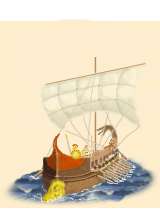Pentekonteroi
 |
Weapons | Defence | Mental | ||||||
|---|---|---|---|---|---|---|---|---|---|
| Primary | Secondary | Armour: | 4 | Morale: | 25 | ||||
| Type: | none | none | Shield: | 0 | Discipline: | normal | |||
| Attack: | 10 | 0 | Skill: | 1 | Training: | untrained | |||
| Charge: | 0 | 0 | Recruitment | Other | |||||
| Lethality: | 1 | 1 | Soldiers: | 13 | Hit Points: | 1 | |||
| Range: | 0 | 0 | Cost: | 2500 | Mass: | 1 | |||
| Ammo: | 0 | 0 | Upkeep: | 700 | |||||
| Turns: | 2 | ||||||||

Small, fast and agile, these ships are great for scouting but almost useless in battle.
Pentekonteroi
Fathers of our fathers used these ships, Great Ruler and won wars with them! But five hundred years have passed since those days. Now such small ships are useful only as scouts and in anti-pirate operations.
Historically, fifty oar ships were used with great success during the "Dark Age" of Greece (IX - VII century). There were two main types of Pentekonteroi: one level and two level ships. One-level was probably an older design (Homer mentions them in Iliad) as they appear unsuitable for battles at sea. More likely they were troop carriers designed for raids against enemy shores. Iconography shows that in the VIII century a new style of fighting was adopted in the form of ramming. This caused a change in ship construction: a bronze reinforcement was added to the front of the ship and it later evolved into a ram. Now, ships needed to be more manoeuvrable (which meant shorter hulls) and faster (which required more oarsmen). As a solution to these opposing needs, the two-level system was adopted. About 20 men sat inside the hull, rowing through small holes, while another 30 sat above them with oars placed on the railing. Scientists are not sure where this development first occurred, but Greeks from Ionia and Phoenicians are among the possible inventors. A ship of this design was a "powered ram" and required only a tiny deck crew (with only a few soldiers). For longer voyages sails were used: a large one on the central mast and another on the shorter foremast. Triereis made these ships obsolete around VI-V century, and their role was reduced to scouting duties and "ships for the poor". They were sometimes used on rivers as flagships for flotillas of even smaller ships. We know that Alexander the Great ordered the building of one Pentekonteros before crossing the Hydaspes, and used it later on the Indus. But this ship was probably a larger one-level Pentekonteros - more suitable for transporting troops.